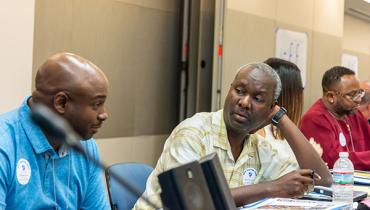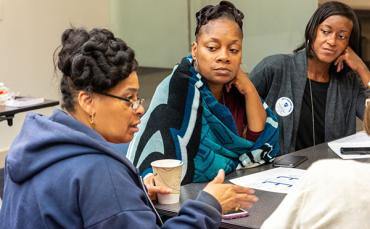It’s well-known that teachers of color significantly boost academic achievement among students of color—and enhance the learning experience of all students—but how to recruit and retain such teachers is less clear. To push for possible solutions, grow its own teaching workforce and address the dire need for more teachers, the AFT held a diversity summit June 21-23 in Washington, D.C., where union leaders shared the challenges and some of the successes they’ve had as they build a more diverse educator workforce. The idea, explained AFT President Randi Weingarten, is to “get the best thinking from our members and our leaders” to come up with tangible solutions that will drive meaningful change on the local level. The work group will deepen the AFT’s work on this issue, aiming to create a toolkit that will help members develop “Grow Your Own” teacher development programs.
What’s the problem?
The summit opened with researcher Conra Gist, a leading education scholar from the University of Arkansas, outlining the problem: White teachers far outnumber black teachers, despite the fact that the number of public school students of color, especially black and Latino students, is increasing. In the 2015-2016 school year, 80 percent of teachers were white, compared with just 49 percent of students. Seven percent of teachers were black, compared with 16 percent of students. Nine percent of teachers were Latino, compared with 26 percent of the students.
Why is that important? Research shows that teachers of color enhance the learning experiences of all students, and for students of color, their presence is crucial. Teachers of color are more likely to see a black or brown student’s potential and recommend him or her for advanced classwork. These teachers have higher expectations of their students of color and act as relatable role models and mentors. This results in higher achievement for their students, who also are more likely to attend school and participate in extracurricular activities. Teachers of color also serve as “potential justice warriors,” added Gist, and often “bring attention to the need for policies, practices and programs that squarely address the complexity of race and racism in K-16 schools.”
But obstacles to increasing the number of teachers of color in our schools abound. From the monumental loss of black teachers during school integration, when white administrators in newly integrated schools refused to hire black teachers, to modern-day school closures in communities of color in places like Chicago, the number of black teachers has decreased for decades. “The ‘turnarounds’ and the closings and reconstitutions are purging black teachers,” said Stacy Davis Gates, political director of the Chicago Teachers Union. “Entire communities have been impacted in this way.”
There are also barriers built into the teacher education system, such as testing bias and lack of access to college. Even if teachers make it into the system, there’s an enormous problem with retention in schools that are unfamiliar or unwelcoming places for new teachers of color, who frequently have little support once they enter the classroom. In the 2011-2012 school year, 29,596 teachers of color were hired in American schools, but 50,813 left due to attrition, Gist said.
It doesn’t help that the teaching profession has been devalued, with respect for the work and pay both plummeting. “It’s hard to recruit people to join us,” said Marcus Walton, an executive board member of the Detroit Federation of Teachers and a vice president of AFT Michigan. Nationally, there’s been a 35 percent decline in enrollment in teacher preparation programs in the last five years, according to the Learning Policy Institute, with 240,000 fewer teachers of any race entering the pipeline in 2014 than there were in 2009.
‘Grow Your Own’
One popular solution to the shortage of teachers of color is the “Grow Your Own” approach, which supports paraprofessionals and other community members on their path to becoming teachers. These programs have had some success in Illinois, where the Chicago Teachers Union contract requires that Chicago Public Schools make intentional efforts to diversify its teacher workforce. Grow Your Own Illinois provides tuition assistance, funds for books, counseling, tutoring, mentoring and stipends for transportation and child care, among other services.
The Saint Paul Federation of Teachers in Minnesota negotiated scholarships for paraprofessionals who want to attend education courses, said AFT Executive Vice President Mary Cathryn Ricker, who was SPFT’s president at the time. “Any para could apply for any higher ed course exploring teaching,” she said, noting that one of the most effective elements of the program is ensuring that paraprofessionals keep their salary and benefits while student teaching.
In Connecticut, the Grow Your Own program is divided into three parts by the type of recruit, explained Jan Hochadel, president of AFT Connecticut: One targets students, inspiring them to become teachers; another creates a track for paraprofessionals; and a third involves parents, who are also deeply rooted in the community. “We see it as a three-legged stool,” said Hochadel.
In New York City, the United Federation of Teachers helped establish a career ladder for paraprofessionals and also targets career and technical education students who can attend a five-year program and graduate from high school certified to teach their trade in a CTE program. Pittsburgh Federation of Teachers Vice President Hannah McCarthy runs a teaching magnet at her high school, where students follow a track that includes hands-on classroom time in local elementary schools. The program has resulted in a number of graduates returning to the area to teach.
David Gray, president of the Oklahoma City Federation of Classified Employees and an AFT vice president, is working with the school district and other community partners to expand a pilot program that prepares students for teaching careers; the goal is to attract more students of color. Gray is deeply committed to the program and calls the lack of diversity in the teaching professional a “crisis” that demands immediate attention at all levels.
Of course, all of the GYO programs require funding, which is in short supply.
Jamie Williams described a program in Texas that allows paraprofessionals with five years of experience in the classroom to skip student teaching; Demetria Walker-Smith says a similar program has been established in Virginia. AFT Connecticut has prioritized raising the percentage of teachers of color with a memorandum of understanding that supports paraprofessionals going through a part-time teacher-prep program and, provides them a $3,000 refund on the $5,000 program if they stay in Hartford Public Schools. These programs are especially important among people who cannot afford to quit their jobs while they do their student teaching. “People can’t do the student teaching because they have to leave their jobs to do it,” said Ricker—a problem addressed by the SPFT’s contract measure ensuring paras get their salaries throughout their student teaching.
Other places are looking to historically black colleges and universities for recruitment and partnerships. Non-HBCUs are engaged as well: Cheryl Holcomb-McCoy, dean of the School of Education at American University in Washington, D.C., described her school’s “teacher pathway pipeline focused on diversity,” which was created in partnership with the Washington Teachers Union and the District of Columbia Public Schools. It places a diverse group of 10 local 11th-graders into two education courses at AU, and offers scholarships and guaranteed jobs in DCPS if they finish the program. The university is also working on more culturally relevant pedagogy.
Whatever method a district uses to improve its diversity, Gist and others underscored the importance of valuing “cultural wealth”—the unique assets students of color bring to their education. Gist named things like “aspirational capital,” that is, “the ability to maintain hopes and dreams for the future even in the face of real and perceived barriers,” and “navigational capital,” that is, the ability to maneuver through social institutions despite obstacles put in their way. Other strengths of students of color include the “social capital” of family and community networks, and the “resistance capital” of having practiced the “oppositional behavior” needed to counter inequity. Gist suggested teachers should be “able to see strength where other people see lack, able to see genius where other people see you shouldn’t be in school.”
“We don’t think diversity is enough,” said Jim Randels, president of the United Teachers of New Orleans. “The students have to understand the wealth of their communities.”
Aside from supporting new teachers, there was talk of training teachers who are already in place, supporting mandatory cultural relevancy and restorative justice training as part of professional development, and perhaps embedding it in teacher certification programs.
Staying power
In some cases, Grow Your Own programs are successful but the attrition rate among new teachers is high. Many around the table agreed that new teachers are frequently evaluated out of schools that are too rigid in their definition of teacher success.
Johnny McInnis, political director at the Boston Teachers Union, described a court order mandating that 25 percent of the teachers in the Boston schools be African-American, but said that numbers have declined because of attrition. “Teachers are evaluated out,” he says. “Older teachers are pushed out, and they’re not rehiring. There need to be some things in place for retention.” His local issued a report detailing the failure in Boston to diversify the teaching workforce and urging the district to do better.
In Baltimore, paraprofessionals benefit from a strong track that helps them earn their teaching certification, and a mentoring program, involving monthly meetings and classroom visits with seasoned teachers, goes a long way in keeping them in the profession. But even then, attrition can be a problem.
Take-away tools
In addition to the examples members were able to provide from their own locals, Ryan Saunders from the Learning Policy Institute walked summit participants through a Teacher Shortage Solution Toolkit, with facts on the teacher shortage and on the dearth of teachers of color, state-by-state statistics about the cost of teacher turnover ($16 million in Boston), information on attrition (the primary driver of teacher shortages) and the decline in teacher preparation programs. The information, including possible solutions such as service scholarships, training and support, and competitive compensation, is designed to be used in advocacy for funding and programming to address the lack of diversity in teaching.
Read the AFT’s collection of member blog posts about their personal experience with diversifying the teacher workforce, on AFT Voices.
[Virginia Myers]



